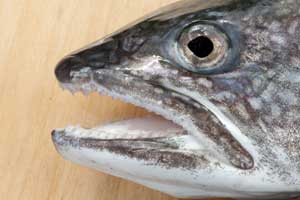Lake Trout Features and Size

How to Identify Lake Trout
The Lake Trout is a slender fish length-wise like trout and salmon. Although heavier fish will appear a lot more stocky in appearance especially the largest fish.
They have white leading edges on all its lower fins and light colored spots on a dark background that has often been described as having a worm pattern.
It’s tail is moderately forked, more than the other Charr. Like other Charr, its scales are small making its skin feel smooth and soft. It has a large head, but it will appear smaller the larger the fish grows. It looks quite small on a 50 pound fish.
Lake Trout Body Color
The body color is typically grayish to brownish, with white or nearly white spots that extend onto the dorsal, the adipose, and the caudal fins. However, the brightness or darkness of the Lake Trout depends largely on where it is found.
Coloration is highly variable. Lighter specimens are often the deep-dwelling fish of light-colored southerly lakes with alewife and smelt forage bases. Darker specimens, including some with reddish and orange tones, come from less fertile, tannin-colored northern lakes.
Lake Trout Size
If like a lot of other people you think these fish don’t get much bigger than 4 or 6 pounds, you’re going to find it hard to believe what I’m about to write. For the rest of you, you may still be surprised at the size of the largest Lake Trout ever caught.
These fish are truly massive considering that they are caught in freshwater lakes and rivers.
102 Pounds
In 1995, a 72 pound/33 kg Lake Trout was caught in Great Bear Lake, Northwest Territories. Then in 2001, a 74 pound/34 kg Lake Trout in the same location. However, these were both all-tackle records.
- All tackle means that they were caught with a fishing rod, fishing lines and tackle.
In 1961 a massive 102 pound/46 kg Lake Trout was caught in Lake Athabasca, Saskatchewan using a net.
While Lake Trout grow more slowly in colder climates, there are less anglers to disturb the population so the fish there are much larger than Lake Trout found in over-fished lakes and rivers in the northern United States and Southern Canada.
Lake Trout Age
The average age will depend on the location. Remote locations in the Yukon, Nunavut and the Northwest Territories will see larger and much older Lake Trout than those found in Lake Ontario and smaller lakes to the south and west.
Lake Trout Location
They are no more difficult to catch than any other fresh water fish like the Largemouth Bass or Arctic Charr.
- The key is understanding where it feeds and how it reacts to sound, light and bait. They also go much deeper in the lakes than most other freshwater fish.
Let’s focus on deep dwelling Lake Trout. Expect them to be around 70 to 100 feet/21 to 30 meters down when the water temperature reaches 53°F/12°C.
They’re usually in the deepest parts of the lake when summer is at its hottest.
When the temperatures in the lake start to cool with the onset of September, Lake Trout will migrate back towards rocky shorelines where they spawn in the months of September and October.



